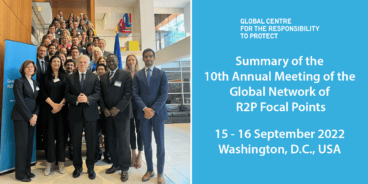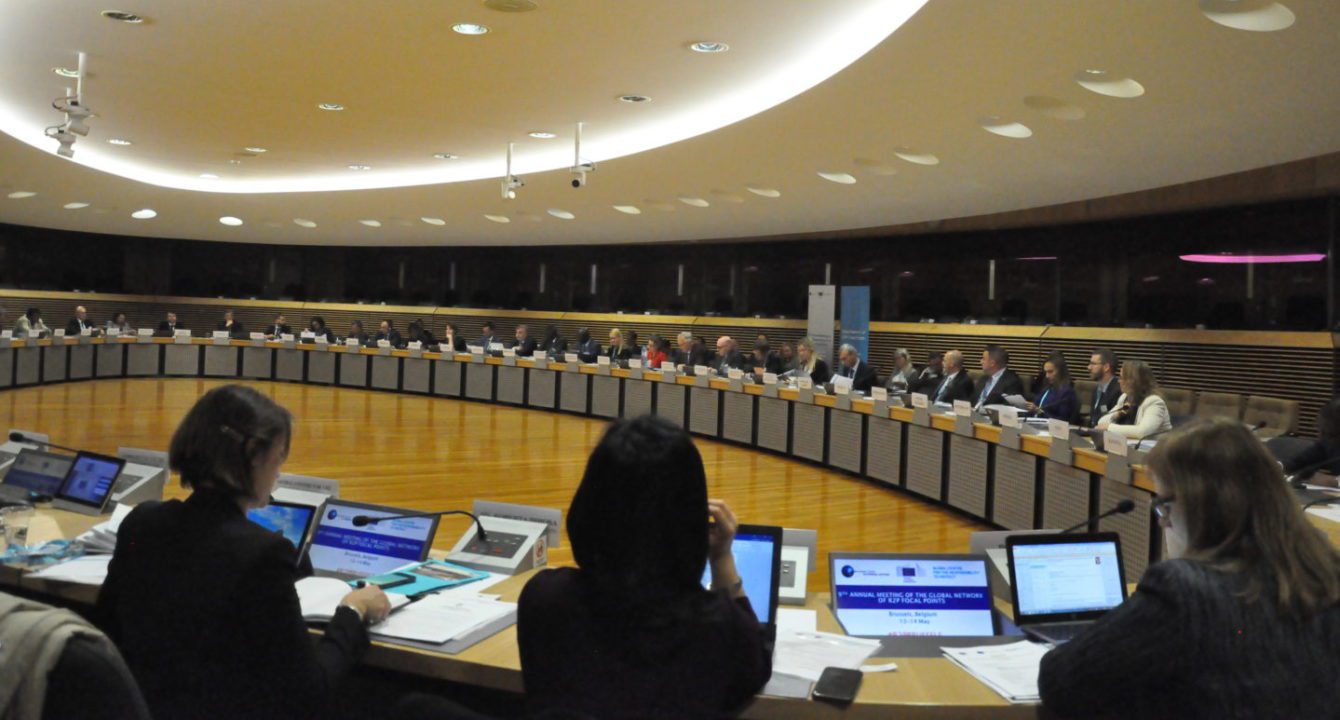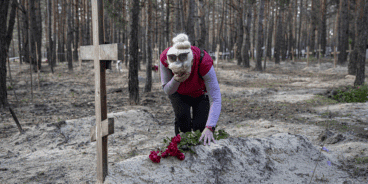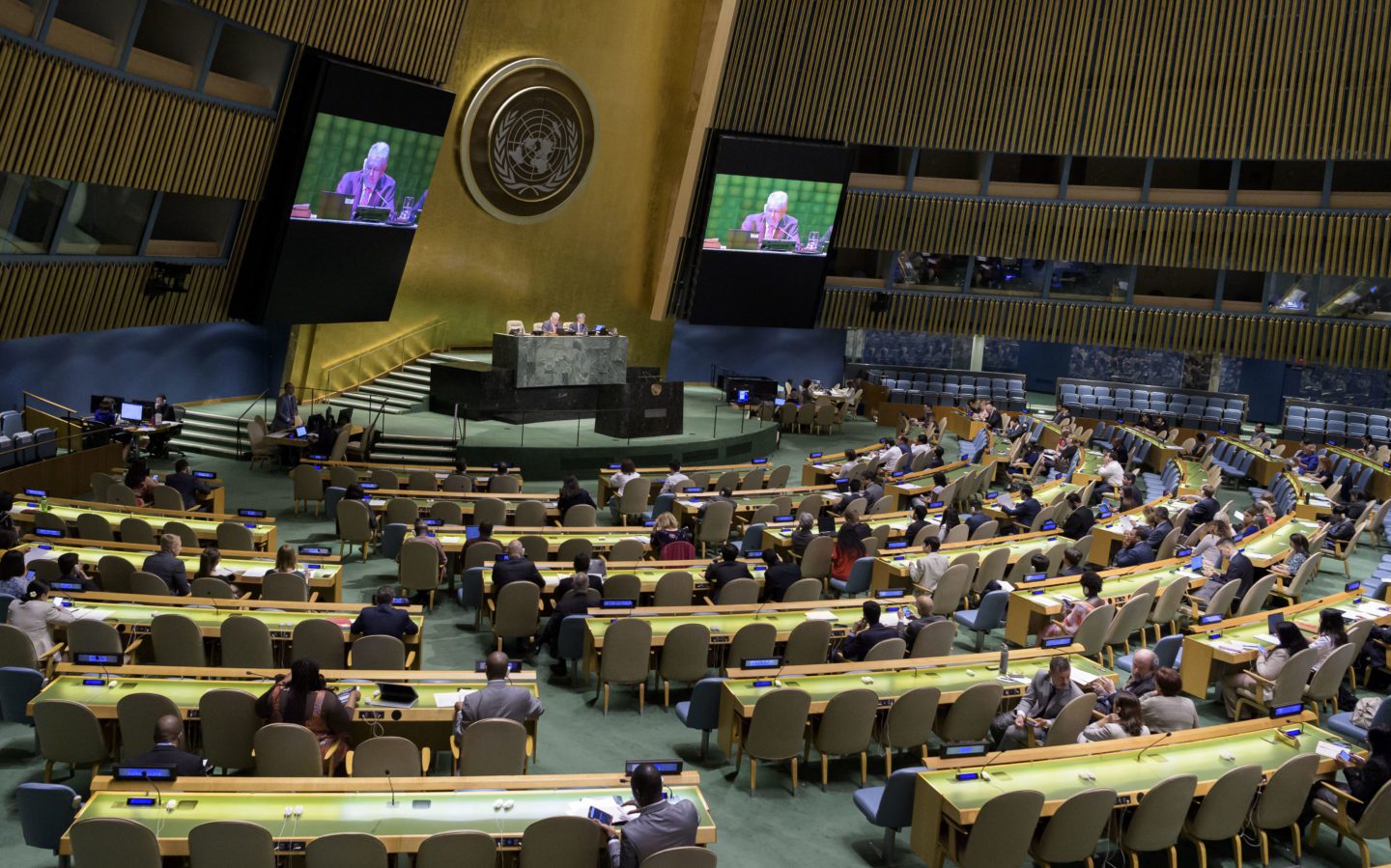

Summary of the Ninth Annual Meeting of the Global Network of R2P Focal Points, Brussels, Belgium, 2019
The European External Action Service, the European Commission and the Global Centre for the Responsibility to Protect co-hosted the ninth annual meeting of the Global Network of R2P Focal Points in Brussels, Belgium from 13 to 14 May 2019. This was the first meeting of the Global Network hosted by a regional organization. The meeting brought together senior government officials from more than 45 countries as well as representatives from the United Nations and several regional organizations, including the European Union (EU), Organization of American States (OAS), African Union (AU), Organization for Security and Co-operation in Europe (OSCE) and Council of Europe.
During the meeting R2P Focal Points discussed the unique role regional organizations play in preventing and responding to atrocities and innovative measures implemented by such organizations. Participants discussed how R2P Focal Points can influence decision- making within their governments on particular mass atrocity situations and examined the cases of Myanmar, Venezuela and Yemen. In doing so, they discussed national and global best practices in the development of tools to prevent and halt genocide, ethnic cleansing, war crimes and crimes against humanity. Led by expert presentations, R2P Focal Points also discussed the linkage between R2P and the Women, Peace and Security (WPS) agenda, particularly with regard to addressing sexual and gender-based violence.
Participants highlighted the need for all states and regional organizations to appoint an R2P Focal Point that can sensitize their colleagues to the range of tools available in their own governments to uphold R2P at home and abroad. Recently, the OAS appointed an R2P Focal Point, joining the EU as the second regional organization in the Global Network. The meeting concluded with R2P Focal Points listing options for the further implementation of R2P during the coming year, which are enumerated in this summary. While undertaking such actions, the 61 national and 2 regional R2P Focal Points may be guided and supported by the recently-formed Steering Group for the Global Network. The Steering Group, which was formally introduced during the ninth annual meeting, is currently comprised of Australia, Denmark, Ghana, Lithuania, Slovenia and the Global Centre for the Responsibility to Protect in its capacity as the Secretariat of the Global Network.
The following summary provides an overview of the key messages delivered by expert panelists as well as the outcome of discussions amongst R2P Focal Points during the two-day meeting.
OPENING CEREMONY
The ninth annual meeting was opened by the Deputy Secretary General of the European External Action Service and R2P Focal Point for the EU, Mr. Christian Leffler. Mr. Leffler was joined by the Director of the Service for Foreign Policy Instruments of the European Commission, Mrs. Hilde Hardeman; the UN Special Adviser on the Prevention of Genocide, Mr. Adama Dieng; the UN Special Adviser on the Responsibility to Protect, Ms. Karen Smith; the Director General for Multilateral Affairs and Globalisation of Belgium, Mr. Axel Kenes; and Executive Director of the Global Centre for the Responsibility to Protect, Dr. Simon Adams.
In her opening remarks, Mrs. Hardeman stressed the various tools that the EU has at its disposal to uphold its commitment to R2P, including sanctions, horizon scanning, cooperation and capacity building. The EU is implementing R2P externally in a variety of ways, including through providing support to strengthen civilian protection policy and practice, for instance by promoting more effective protection of civilians by security forces in Nigeria, sensitizing warring parties in Ukraine to the consequences of violent conflict on civilians, and supporting the International, Impartial and Independent Mechanism for Syria to ensure accountability for mass atrocity crimes.
Special Adviser Dieng highlighted that more work must be done to ensure that early warning is followed by appropriate early action. He noted ultra-nationalism is a factor legitimizing inflammatory language and hate speech around the world, which has led to an increase of hate crimes – an early warning sign for mass atrocities. While asserting that we must avoid resorting to “Lowest Common Denominator Diplomacy” around human rights and the prevention of atrocities, Dr. Adams provoked discussion by highlighting situations where early preventive action assisted in enabling states to uphold their responsibility to protect. He particularly noted the cases of The Gambia and the Solomon Islands, where concerted efforts by regional partners helped prevent atrocities from taking place.
In her keynote address, Special Adviser Smith stressed that the failure to protect populations in Myanmar, South Sudan and Syria does not represent a failure of the R2P principle, it rather represents a consequence of the crisis of multilateralism. She called for an R2P lens to be added to both conflict prevention and development and noted that further work is needed to integrate R2P at the UN and drive forward the WPS and Protection of Civilians agendas, particularly since the UN Security Council tends to frame R2P as a security issue, neglecting its human rights dimension.
ATROCITY PREVENTION IN PRACTICE: THE VIEW FROM REGIONAL ORGANIZATIONS
Regional organizations play a unique role in preventing and responding to mass atrocities as well as in taking effective collective action to protect civilians. Regional organizations are often best placed to guide multilateral action on emerging atrocity situations in their region as they may have a better political understanding of dynamics within the countries where atrocities are taking place and are composed of neighboring states who may be disproportionately affected in the aftermath of atrocities. During this session, individuals from several regional organizations – including the R2P Focal Points of the EU and OAS – spoke about how R2P relates to their institutional mandate and what tools their organizations have for assisting states in the prevention of atrocities and responding to emerging risks in their region.
All regions have experienced mass atrocity crimes, and no part of the world today is immune to atrocity risks. Participants discussed how regional organizations have been shaped by the history of the inter-state dynamics within their region and the lessons learned in addressing previous failures in cooperation. For many regions, including Europe, this has taken the form of mechanisms for ensuring the maintenance of peace and security between states that have a history of armed conflict. For the African Union this means reinforcing the principles of non-indifference and the need to create dynamics where the occurrence of atrocities in their region becomes unimaginable. Regional organizations have also played an active role in ensuring accountability for atrocities. For example, the OAS signed a cooperation agreement with the International Criminal Court (ICC), and in 2018 it supported the decision of Argentina, Chile, Colombia, Paraguay, Peru and Canada to refer to the situation in Venezuela to the ICC, marking the first group referral to the Court.
The panelists emphasized that while the language of R2P may not be in their organizations’ founding documents, many regional organizations operate within the spirit of mass atrocity prevention. Institutional mechanisms for providing technical assistance to member states and various regional field operations support implementation of R2P’s Pillar II, for example. Participants also noted the value of creating partnerships between organizations that can aid in the development of mutually supportive strategies for the prevention of atrocities, such as the AU- EU-UN trilateral partnership. Participants from regional organizations emphasized the need to strengthen collaboration in order to share best practices and develop relevant preventive tools.
The EU R2P Focal Point asserted that for his organization, upholding R2P is about defending the EU’s interests: stability and security. The EU’s “Integrated Approach” to conflicts and crises ensures that all EU foreign policy instruments allow for the identification of early warning and the appropriate tools to confront emerging risks. During his remarks Mr. Leffler stressed that R2P should not be viewed solely as a foreign policy issue. Radicalization, xenophobia, and the increasing acceptance of inflammatory language in some European countries illustrate the internal/external policy nexus.
Notably, the EU has undertaken a number of initiatives to confront the role of social media as a vehicle for hate speech and radicalization. In May 2016, the European Commission agreed with Facebook, Microsoft, Twitter and YouTube on a “Code of conduct on countering illegal hate speech online.” During the last year, Instagram, Google+, Snapchat, Dailymotion and jeuxvideo.com announced the intention to join the code of conduct.
IMPLEMENTING R2P: IDENTIFYING SUCCESSES AND CHALLENGES IN PREVENTING ATROCITIES
During this session participants discussed their experiences in their role as an R2P Focal Point, addressing enduring challenges as well as successes in engineering a response from their government to prevent and halt atrocities in specific country situations. R2P Focal Points articulated the unique challenges they faced in influencing decision-making within their governments around a particular situation, but also shared practices that have been instrumental in triggering action within their governments and regional organizations. The session opened with a testimonial from a survivor of the conflict in Syria, Ms. Noura AlJizawi, who now works with female survivors of detention and sexual violence through Star Point, an organization she founded.
The session featured three break-out groups focused on situations where the UN Security Council has struggled to agree to collective responses and the international community has been forced to find creative solutions to addressing atrocity risks: Myanmar, Yemen and Venezuela. In the cases of Myanmar and Yemen, states indicated the value in being active across multiple UN fora, including supporting monitoring mechanisms within the Human Rights Council, funding mechanisms and condemning atrocities through the General Assembly, and prioritizing atrocity situations during presidencies in the Security Council. With regards to Venezuela and Yemen, participants also discussed how regional organizations, such as the EU and OAS, and efforts of neighboring states, such as the initiatives of the Lima Group and the Montevideo Declaration, have generated collective political will and potential alternative solutions to ongoing crises.
Across all three situations, R2P Focal Points identified a number of common lessons and obstacles:
- R2P Focal Points have a special responsibility to communicate the urgency of atrocity situations to their political leadership, even when a country is not necessarily a foreign policy priority for their government.
- Part of being committed to non-indifference is taking steps to support mechanisms for response. As there is strength in numbers, members of the Global Network of R2P Focal Points or Group of Friends of R2P should actively support initiatives within the UN Security Council, Human Rights Council, General Assembly or regional bodies on issues related to preventing or halting atrocities.
- States should support briefings within the Security Council on emerging atrocity situations, including by inviting the Special Advisers on the Prevention of Genocide and the Responsibility to Protect and the Office of the High Commissioner on Human Rights.
- In the absence of a Security Council resolution or statement, member states concerned with particular country situations can still provide the impetus for UN agencies to assess the situation from a humanitarian or human rights perspective, which can potentially prompt further action.
- The international community continues to struggle to translate early warning into timely action. A key step to bridging this gap is taking action prior to an escalation in the situation, rather than waiting for atrocities to trigger a belated reactive response.
- Prevention and justice are inter-linked and must be pursued simultaneously. We should also not divorce R2P and issues of accountability from the political track. R2P Focal Points should encourage political directors to see their mandate holistically and ensure atrocity prevention and accountability are part of any proposed solution to a crisis.
- States must support the activism of local civil society, women and youth. Civil society organizations often have better access to populations within countries and can be helpful interlocutors in the prevention of conflict and mass atrocities.
- It remains essential to find ways to demonstrate support for vulnerable populations and those affected by atrocities, including through providing bilateral and multilateral assistance and cooperation with national mechanisms for prevention.
BEST PRACTICE: PREVENTING ATROCITIES THROUGH INSTITUTIONAL MECHANISMS AND INNOVATION
States and regional organizations have developed and supported various mechanisms and tools to prevent atrocities. These range from to enhancing risk assessments, to creating international investigative mechanisms to collect and preserve evidence of atrocities committed in Syria and Myanmar, to supporting initiatives at the UN Human Rights Council and Security Council that bring attention to specific country situations where civilians are at risk of atrocities.
During this session R2P Focal Points were briefed on a number of tools that may be instrumental in the identification of atrocity risks in situations around the world and the development of appropriate responses. This included briefings on the EU’s “Responsibility to Protect Atrocity Prevention Toolkit” and the UN’s “Framework of Analysis for Atrocity Crimes.” The UN’s Framework of Analysis, developed by the Office of the Special Advisers on Genocide Prevention and R2P, lists 14 risk factors for mass atrocity crimes and helps to systematize the collection of information on risks to populations. The EU’s recent Toolkit describes structural risks and imminent warning signs of atrocities, and also provides guidance on how EU delegations within other countries can respond to warning signs and address mass atrocity risks. The Toolkit has been disseminated to all EU delegations and missions around the world.
The Global Centre also presented the newly updated Manual for R2P Focal Points, which has been produced in consultation with R2P Focal Points. The Manual is a tool that offers practical guidance to R2P Focal Points. It outlines tasks that R2P Focal Points should undertake from the time of their appointment until they leave their position, including guidance regarding how to operationalize atrocity prevention within their departments and governments.
The session also featured a briefing on the work of the UN Human Rights Council-authorized Fact-Finding Mission on Myanmar. The discussion demonstrated the value of such tools in documenting evidence of crimes, monitoring the ongoing human rights situation in the country, and supporting various accountability tracks.
A key element of prevention and response to mass atrocity crimes is raising awareness of R2P and the atrocity prevention lens within governments as well as regional and international institutions. Both the EU’s Atrocity Prevention Toolkit and the UN’s Framework of Analysis can be utilized for this purpose. In addition to sharing these documents and sometimes translating them into local languages, states have undertaken other initiatives to raise awareness of R2P locally. In this regard, R2P Focal Points were briefed on the regional meetings of European R2P Focal Points and a bi-annual academic conference on R2P that took place in Ljubljana, Slovenia, earlier in May 2019.
IMPLEMENTING R2P: LINKAGES WITH THE WOMEN, PEACE AND SECURITY AGENDA
Effective implementation of R2P requires an understanding of how atrocity prevention is intrinsically connected to other diverse protection agendas, including the Protection of Civilians, Children and Armed Conflict, and WPS agendas. This session explored the linkage between R2P and the WPS agenda, particularly focusing on sexual and gender-based violence (SGBV). The discussion was guided by an expert presentation from a member of the WPS Focal Points network as well as Ambassador Mara Marinaki, the European External Action Service’s Principal Advisor on Gender and on the implementation of UN Security Council Resolution 1325.
Since R2P and the WPS agenda emerged in the early 2000s, both have transformed dialogues on human rights and the maintenance of international peace and security. The nature of SGBV means that the aims of atrocity prevention and fulfilling commitments under Resolution 1325 are mutually reinforcing. Several Security Council resolutions recognize that sexual violence can itself constitute war crimes or crimes against humanity and may even amount to a constitutive act of genocide.
The R2P Focal Points noted that extreme structural and institutional violence against women is a potential risk factor for gross human rights violations, and early warning systems must have a gender lens. Approaching protection holistically is crucial for ensuring that women’s security is properly addressed. In this context, Ambassador Marinaki briefed the R2P Focal Points on the new EU Strategic Approach to WPS, adopted in December 2018.
States and regional organizations have undertaken a number of measures to uphold commitments to R2P and WPS in parallel, including adopting conclusions on WPS and SGBV that address atrocity risks and integrating a gender perspective and applying the atrocity prevention lens to all of their work across the conflict cycle (from stabilization to protection of human rights and strengthening community resilience). Many states within the Global Network have appointed both an R2P Focal Point and a WPS Focal Point who work collaboratively on shared agendas. States were urged to support multilateral efforts, including by ensuring joint analysis units within peacekeeping missions are assessing SGBV and other atrocity risks, and encouraging states to adhere to obligations under international law which specifically highlight women’s rights and accountability for SGBV.
In addition to addressing SGBV and the risk of atrocity crimes, participants discussed how to recognize women and other vulnerable groups as agents of change. Women affected by mass atrocities, violence and conflict around the world have always been – and continue to be – essential for mitigation strategies. Utilizing the knowledge of female experts and conducting gender- sensitive investigations, including through fact-finding missions or Commissions of Inquiry, can ensure that women’s perspectives and needs are discussed. Increasing the visibility of women in areas affected by violence, including through the presence of female peace negotiators, peacekeepers or political representatives, may strengthen women’s leadership and provide an opportunity to build trust with local communities and victims.
CONCLUSION AND RECOMMENDATIONS
The ninth annual meeting provided an opportunity for R2P Focal Points to share national and regional best practices in the prevention of mass atrocities. Many recommendations for tasks the R2P Focal Points can undertake throughout the year emerged from these discussions, including:
- States, as well as regional and international organizations, should prioritize the protection of vulnerable populations from mass atrocity crimes. One role of the R2P Focal Point is to identify situations that necessitate a preventive response and ensure they are framed in a way that mobilizes appropriate action by their government.
- States, as well as regional and international organizations, should raise awareness of R2P and its principles within their governments and institutions. R2P Focal Points should sensitize their colleagues to the range of policies and practices that can be implemented to prevent mass atrocities, and the forms of leverage that their governments might have in confronting such crimes around the world. One way of doing this is by linking atrocity prevention to other foreign policy objectives and policy agendas (e.g. WPS and Children and Armed Conflict).
- States should reach out to those who are not yet part of the Global Network to help clarify the norm and encourage them to appoint an R2P Focal Point. States within regional groupings that have not appointed an R2P Focal Point should investigate how to apply collective pressure on relevant regional organizations to encourage the appointment of a regional R2P Focal Point.
- R2P Focal Points should support and actively mentor one another, including through sharing experiences, analyses and assessments; developing joint positions and strategies; and working together across the Global Network to achieve common goals. Some of this mentorship can be facilitated by the Steering Group of the Global Network. R2P Focal Points should also utilize the Manual for R2P Focal Points to help guide their work.
- Multilateral organizations should draw upon the example of EU-AU-UN triangular cooperation, to strengthen their collaboration on R2P and seek ways to share best practices and develop relevant tools to address atrocity risks.
- States and regional organizations should capitalize on the inclusion of R2P on the formal agenda of the UN General Assembly as well as on the 2020 observation of the 15th anniversary of the adoption of R2P through the UN World Summit Outcome Document by sharing and publicizing R2P success stories with each other and with the Secretariat.
Related Publications


Atrocity Alert No. 318: Ukraine, Syria and the Global Network of R2P Focal Points
